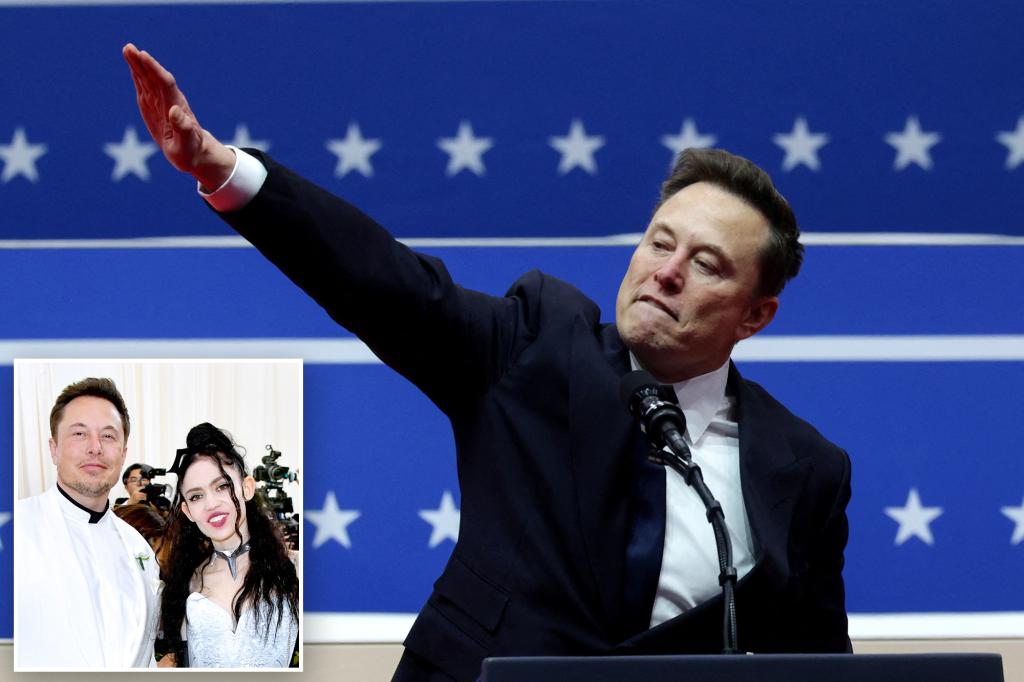The recent online furor surrounding Elon Musk’s allegedly offensive gesture at the inauguration and its subsequent impact on his ex-girlfriend, Grimes, highlights the complex dynamics of public perception, guilt by association, and the rapid spread of misinformation in the digital age. The incident began when Musk, attending the inauguration, was photographed making a gesture that some interpreted as a Nazi salute. This triggered a wave of online outrage, with accusations of Nazi sympathy directed at the Tesla and SpaceX CEO. The controversy quickly ensnared Grimes, a musician and artist who shares three children with Musk. Despite having no involvement in the incident, she found herself facing online criticism and pressure to denounce her ex-partner’s actions. This illustrates the phenomenon of guilt by association in the digital age, where individuals can be held accountable for the actions of those they are connected to, regardless of their own beliefs or involvement.
Grimes’ initial response reflected the unexpected and overwhelming nature of the online backlash. Having been offline and unaware of the developing controversy, she expressed surprise at the intensity of the reaction. Her initial statement emphasized her lack of knowledge about the situation and her desire to avoid making a hasty statement. This measured approach underscores the challenges of navigating public pronouncements in the era of social media, where rapid responses are often demanded, but nuanced understanding can be lacking. It also highlights the pressure public figures face to address controversies, even those they are not directly involved in, due to their association with individuals in the public eye.
As the online pressure mounted, Grimes faced increasing demands to clarify her stance on Musk’s gesture. Responding to the escalating situation, she explicitly denounced Nazism and the far-right. This direct and unequivocal statement aimed to distance herself from the ideology associated with the controversial gesture and to quell the online criticism directed towards her. Her willingness to “set the record straight” demonstrates the burden placed on public figures to address controversies and clarify their positions, even when the issues at hand are tangentially related to them. It also underscores the complexities of navigating public image in the digital sphere, where silence can be interpreted as complicity.
Meanwhile, Musk himself responded to the allegations, dismissing them as “dirty tricks” employed by his political opponents. He characterized the accusations as an overused tactic of labeling anyone they disagree with as a Nazi, expressing his weariness with such accusations. This response reflects a broader debate about the use of labels and accusations in political discourse, where terms like “Nazi” can be deployed to discredit opponents, sometimes without sufficient justification. Musk’s reaction highlights the challenges of engaging in productive political dialogue in a climate of heightened polarization and online acrimony.
The Anti-Defamation League (ADL), a prominent organization combating antisemitism and other forms of bigotry, weighed in on the controversy, stating that Musk’s gesture was not a Nazi salute. They characterized it as an “awkward gesture,” effectively dismissing the accusations of Nazi sympathy. This intervention by the ADL played a significant role in de-escalating the controversy. Their expertise and authority on the subject of hate symbols lent weight to their assessment, helping to shift public perception and diffuse the online outrage. Musk’s public acknowledgment and thanks to the ADL further contributed to the resolution of the incident.
This incident, from the initial misinterpreted gesture to the ensuing online outrage and subsequent clarification by Grimes and the ADL, illustrates the complex dynamics of public image, guilt by association, and the rapid spread of information (and misinformation) in the digital age. It highlights the challenges public figures face in navigating the complexities of online discourse, where actions can be quickly misinterpreted, and individuals can be held accountable for the actions of those they are connected to. The episode also underscores the importance of fact-checking and relying on credible sources, such as the ADL, for accurate information, particularly in situations involving sensitive topics like accusations of hate speech or extremist ideologies. The incident serves as a cautionary tale about the speed and intensity with which online controversies can erupt and the potential for collateral damage to individuals who are indirectly involved. It also emphasizes the importance of considered responses and the role of authoritative voices in de-escalating online conflicts and providing accurate information.

